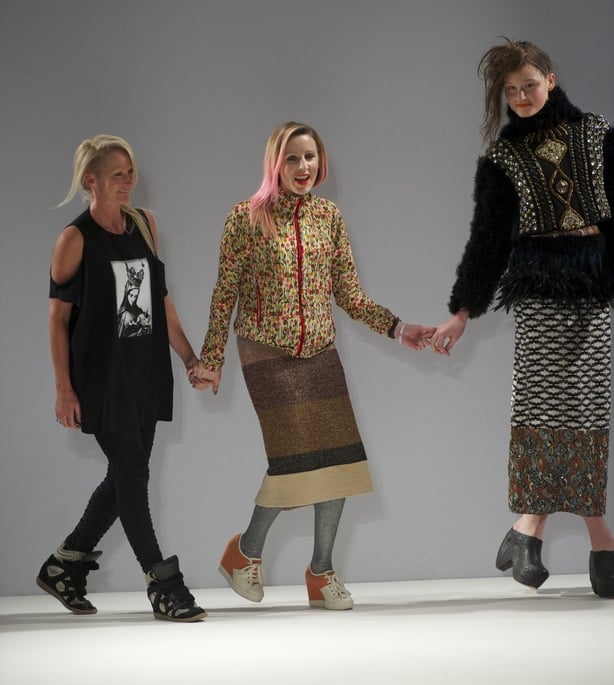When Joanne Hynes started transforming some of her earliest designs into artwork for her first solo exhibition, she began by ripping them apart.
"I was kind of shaking when I did it", she recalls. "And it was always kind of emotional because it was kind of like killing your darlings. But it was freeing as well, because it's just being in the process of design and making and working within to work out outwardly, going back to reconcile, to move forward."
The exhibition, called What We Carry with Us, opened recently in the Kevin Kavanagh Gallery in Dublin City centre, and featured a showing of work that seemed at once far removed from Hynes' eclectic and bold designs – particularly for Dunnes Stores – and also keenly evocative of what the Irish designer always always managed to unlock from the clothes we wear.
Framed sculptural dresses, high definition scans of designs laid out with gathered items, vintage pieces chopped up and torn inside out, with their ghostly replicas beside them, and – perhaps most intriguing – Hynes' own written texts, pulled from notebooks she's kept over 15 years, all documenting her process and inspirations were among the artworks on show.
We need your consent to load this Instagram contentWe use Instagram to manage extra content that can set cookies on your device and collect data about your activity. Please review their details and accept them to load the content.Manage Preferences
Possibly typically for a designer, Hyne's show was an embodied one, with forms and figures, and imagined women, peppered throughout. Hynes' own body had a visceral reaction to the process, she told RTÉ Lifestyle.
Referencing one design, she said, "I sandpapered it, and I tea stained it, and it was all innately, me making it. I remember making it.
"And I remember later on when I went back to it and I sewed it onto the canvas, my body remembered being there 22 years ago."
Just as she remembers who she was when she created some of her pieces, she remembers the imagined women that inspired them. Many of her collected archive pieces were sourced in vintage shops, and Hynes would, even then, put fierce effort into picturing the women who wore them.
"I'm always, always on the side of the complicated woman", she says.
We need your consent to load this Instagram contentWe use Instagram to manage extra content that can set cookies on your device and collect data about your activity. Please review their details and accept them to load the content.Manage Preferences
One such complicated woman, in Hynes' mind, was who she calls 'The Purple Woman', an older lady she encountered in an airport in Milan who still inspires her work, and who she's been "carrying for 15 years".
"You know that thing when you're in an airport, you're very receptive because you're travelling and you can see things? Your eye is tuned in a different way. But she was wearing a purple suit and there was something not quite right.
"I found myself looking again and looking at more women like that and empathising with so many other characters.
"I don't know anything about this woman. I literally [have] this photograph of the back of her", she says. "I'm not reducing a person to an aesthetic, but she represented some kind of an aesthetic that I'm always trying to look at."
We need your consent to load this Instagram contentWe use Instagram to manage extra content that can set cookies on your device and collect data about your activity. Please review their details and accept them to load the content.Manage Preferences
Hynes says that her work in the exhibition draws from the same well of inspiration that her retail collections do, though to look at them the pieces look like a work in progress.
"There's an unfinishedness to some of the garments that kicks back to the aesthetics that I would have always been attracted to in college", she says. "So Martin Margiela and all the kind of avant garde designers that are still in my heart that way. I don't always get to kind of do that with fashion."
She's quick to note that neither form of work is "playing off" one another, but rather "feeding into" each other.
Any of the deconstructed pieces in the exhibition "could appear in a Dunnes collection", she says. "In a very fragmented or maybe in a literal way, I would imagine possibly elements of it will echo, but not in full.
"I wanted to be able to make work that would, in a sense, look at the past, look at work that I did in the past, bring in archive pieces that I've designed in the past that might have been slightly dislocated or kind of lost or maybe not fully in the right home."
In this sense, Hynes comes across most as an artist, someone thinking of her work in a time continuum, a non-linear trajectory that's still unfolding though some of her designs have now been torn apart and repurposed.
When asked how she thinks about Irish designers and creatives making waves on the world stage, Hynes says "we're possibly potentially more comfortable with the idea of fashion now".

"And I also like the fact that the industry, in a sense, has slightly dismantled after COVID, which has broadened out the conversation for lots of other conversations to come in, because I've never really, being honest, felt fully in that conversation.
"I showed in London and I've done shows and all that, but I never really never really fully knew where my home was, if you know what I mean. I never really felt I was fully on that track of what you were supposed to be to be a designer."
With this exhibition completed, however, Hynes says she feels "like it's a pathway to something, definitely".

